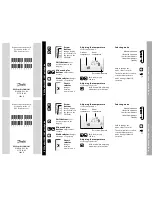
App
- 153
Appendix 5 Method of replacing High Performance model QCPU with Universal model QCPU
APPENDICES
(c) Specifying internal user device as latch ranges
In the same way as for the High Performance model QCPU, latching is available
by specifying internal user devices as latch ranges for the Universal model QCPU.
The ranges can be set on the Device setting tab of PLC parameter.
Internal user devices that can be latched are as follows:
• Latch relay (L)
• Link relay (B)
• Annunciator (F)
• Edge relay (V)
• Timer (T)
• Retentive timer (ST)
• Counter (C)
• Data register (D)
• Link register (W)
POINT
1. If latch ranges of internal user devices are specified in the Universal model
QCPU, the processing time is increased in proportion to the device points set
for latching. (For example, if 8k points are latched for a latch relay (L), the
scan time will be 28.6 s.)If a shorter scan time is needed, remove
unnecessary latch device points to minimize the latch range.
2. Latch range specification of a file register (R, ZR) does not increase the scan
time.
(4) How to shorten the scan time
When data to be latched are stored in a file register (R or ZR), the processing time is
shorter than that for latching internal user device.
Example) Reducing the number of latch points for a data register (D) from 8k
points to 2k points, and using a file register (ZR) instead (When using
the Q06UDHCPU)
* 1: Indicates the time added when file register data are stored in the standard RAM.
TableApp.79 Differences between before and after moving latch points of data register (D) to file register (ZR)
Item
Before
After
Latch points for data register (D)
8192 (8k) points
2048 (2k) points
(6k points are moved to file register.)
Number of devices in the program
Data register (D) (Latch range)
400
100
File register (ZR) (Standard RAM)
0
300
Additional scan time
0.41ms
0.13ms *1
Number of steps increased
---
300 steps
















































